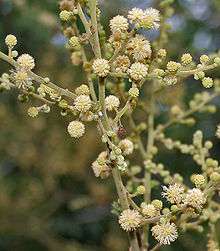Vachellia leucophloea
Vachellia leucophloea (Hindi: रेवंजा), also called reonja, is a moderate sized tree native to South and Southeast Asia.[1] It is sometimes mistaken for Prosopis cineraria with spreading crown and somewhat malformed and crooked trunk. It attains a height of about 20 to 30 ft and a girth of 2 to 3 ft. New leaves appear in April, and yellowish white flowers appear from August to October. The pods ripe by April and the seeds germinate readily if moisture is available. The tree is very hardy and stands drought well. It is frost hardy except in young age. It coppices well and produces good root suckers. It suffers from goat browsing particularly in early stage. Fruits are thin, flat, curved tomentose pods (difference from Prosopis cineraria).
| Vachellia leucophloea | |
|---|---|
 | |
| Flowering in Vanasthalipuram, Hyderabad | |
| Scientific classification | |
| Kingdom: | Plantae |
| Clade: | Tracheophytes |
| Clade: | Angiosperms |
| Clade: | Eudicots |
| Clade: | Rosids |
| Order: | Fabales |
| Family: | Fabaceae |
| Clade: | Mimosoideae |
| Genus: | Vachellia |
| Species: | V. leucophloea |
| Binomial name | |
| Vachellia leucophloea (Roxb.) Maslin, Seigler & Ebinger | |
| Varieties | |
| |
| Synonyms | |
| |
Distribution
Vachellia leucophloea grows natively in India, Nepal, Pakistan, Sri Lanka, Myanmar, Thailand, Vietnam, and Indonesia.[1]
Medicinal uses
The bark extracts of Vachellia leucophloea are used in Pakistan traditional medicine as an astringent, a bitter, a thermogenic, a styptic, a preventive of infections, an anthelmintic, a vulnery, a demulcent, an expectorant, an antipyretic, an antidote for snake bites and in the treatment of bronchitis, cough, vomiting, wounds, ulcers, diarrhea, dysentery, internal and external hemorrhages, dental caries, stomatitis, and intermittent fevers and skin diseases[2] An ethanolic extract ointment has shown marked wound healing activity in trials.[3]
Culinary uses
The bark is used to prepare a spirit from sugar and palm-juice, and in times of scarcity it is ground and mixed with flour. The pods are used as a vegetable, and the seeds can be ground and mixed with flour.[4]
Other uses
The wood is sometimes used to make attractive furniture and other implements, though it can be difficult to work with and is not durable.[5]
References
- "Acacia leucophloea (Roxb.) Willd". PROSEA.
- Imran Imran, Liaqat Hussain, M. Zia-Ul-Haq, Khalid Hussain Janbaz, Anwar H. Gilani, Vincenzo De Feo, "Gastrointestial and respiratory activities of Acacia leucophloea." Journal of Ethnopharmacology Volume 138, Issue 3: Pages 676-682.
- Suriyamoorthy, Sembian; Subramaniam, Kalidass; Wahab, Femina; Karthikeyan, G (December 2012). "Evaluation of wound healing activity of Acacia leucophloea bark in rats". Revista Brasileira de Farmacognosia. 22 (6): 1338–1343. doi:10.1590/S0102-695X2012005000121.
- Sturtevant's notes on edible plants. 1919. p. 19.
- "ACACIA LEUCOPHLOEA – SHADE AND FODDER FOR LIVESTOCK IN AND ENVIRONMENTS". Winrock International.
- R N Kaul (1963): Need for afforestation in the arid zones of India, LA-YAARAN, Vol 13
- R C Ghosh (1977): Hand book on afforestation techniques, Dehradun.
- R K Gupta & Ishwar Prakasah (1975): Environmental analysis of the Thar Desert, Dehradun.
| Wikimedia Commons has media related to Vachellia leucophloea. |